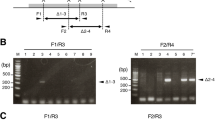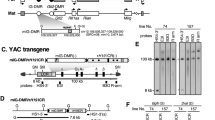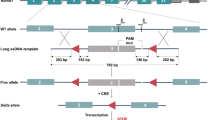Abstract
The imprinted H19 gene produces a noncoding RNA of unknown function. Targeted and transgenic mouse mutations have shown that this RNA can be deleted and overexpressed without adverse effect. Yet one mutation of the H19 gene displayed an embryonic lethal phenotype in the mouse—the expression of an RNA modified by a short insertion near the 5′ end of the transcript (H19Xba allele). Expression of this RNA in transgenic mice conferred lethality at day 14 of development. The potential for this mutant to elucidate the function of the H19 RNA supported further investigation of the H19Xba phenotype. Since all H19Xba transgenic founders died as embryos, an experiment was designed to generate H19Xba-expressing mice that could be maintained as an established line. This strategy took advantage of the maternal-specific expression of H19, passing an H19Xba knockin allele silently through males and transferring it to females only to generate animals for study. Surprisingly, H19Xba knockin mice are fully viable, whether the H19Xba allele is inherited paternally or maternally. Experiments to reproduce the original transgene-based lethality were also performed and yielded live-born transgene-expressing animals. These data demonstrate that, contrary to published reports, expression of the H19Xba RNA does not cause embryonic lethality in mice.





Similar content being viewed by others
Notes
By convention, when superscripts are used to indicate the two alleles of a heterozygous animal, the maternally inherited allele is listed first.
References
Auffray C, Rougeon F (1980) Purification of mouse immunoglobulin heavy-chain messenger RNAs from total myeloma tumor RNA. Eur J Biochem 107: 303–314
Bartolomei MS, Zemel S, Tilghman SM (1991) Parental imprinting of the mouse H19 gene. Nature 351: 153–155
Bell AC, Felsenfeld G (2000) Methylation of a CTCF-dependent boundary controls imprinted expression of the Igf2 gene. Nature 405: 482–485
Brannan CI, Dees EC, Ingram RS, Tilghman SM (1990) The product of the H19 gene may function as an RNA. Mol Cell Biol 10: 28–36
Brunkow ME, Tilghman SM (1991) Ectopic expression of the H19 gene in mice causes prenatal lethality. Genes Dev 5: 1092–1101
Davies K, Bowden L, Smith P, Dean W, Hill D, et al. (2002) Disruption of mesodermal enhancers for Igf2 in the minute mutant. Development 129: 1657–1668
DeChiara TM, Efstratiadis A, Robertson EJ (1990) A growth-deficiency phenotype in heterozygous mice carrying an insulin-like growth factor II gene disrupted by targeting. Nature 345: 78–80
DeChiara TM, Robertson EJ, Efstratiadis A (1991) Parental imprinting of the mouse insulin-like growth factor II gene. Cell 64: 849–859
Elson DA, Bartolomei MS (1997) A 5′ differentially methylated sequence and the 3′ flanking region are necessary for H19 transgene imprinting. Mol Cell Biol 17: 309–317
Hao Y, Crenshaw T, Moulton T, Newcomb E, Tycko B (1993) Tumour-suppressor activity of H19 RNA. Nature 365: 764–767
Hark AT, Schoenherr CJ, Katz DJ, Ingram RS, Levorse JM, et al. (2000) CTCF mediates methylation-sensitive enhancer-blocking activity at the H19/Igf2 locus. Nature 405: 486–489
Ishihara K, Hatano N, Furuumi H, Kato R, Iwaki T, et al. (2000) Comparative genomic sequencing identifies novel tissue-specific enhancers and sequence elements for methylation-sensitive factors implicated in Igf2/H19 imprinting. Genome Res 10: 664–671
Jones BK, Levorse J, Tilghman SM (1998) Igf2 imprinting does not require its own DNA methylation or H19 RNA. Genes Dev 12: 2200–2207
Kaffer CR, Srivastava M, Park KY, Ives E, Hsieh S, et al. (2000) A transcriptional insulator at the imprinted H19/Igf2 locus. Genes Dev 14: 1908–1919
LaSalle JM, Lalande M (1996) Homologous association of oppositely imprinted chromosomal domains. Science 272: 725–728
Leighton PA, Ingram RS, Eggenschwiler J, Efstratiadis A, Tilghman SM (1995a) Disruption of imprinting caused by deletion of the H19 gene region in mice. Nature 375: 34–39
Leighton PA, Saam JR, Ingram RS, Stewart CL, Tilghman SM (1995b) An enhancer deletion affects both H19 and Igf2 expression. Genes Dev 9: 2079–2089
Mattick JS (2004) RNA regulation: a new genetics? Nat Rev Genet 5: 316–323
Pachnis V, Belayew A, Tilghman SM (1984) Locus unlinked to alpha-fetoprotein under the control of the murine raf and Rif genes. Proc Natl Acad Sci U S A 81: 5523–5527
Pachnis V, Brannan CI, Tilghman SM (1988) The structure and expression of a novel gene activated in early mouse embryogenesis. EMBO J 7: 673–681
Pfeifer K, Leighton PA, Tilghman SM (1996) The structural H19 gene is required for transgene imprinting. Proc Natl Acad Sci U S A 93: 13876–13883
Poirier F, Chan C-TJ, Timmons PM, Robertson EJ, Evans MJ, et al. (1991) The murine H19 gene is activated during embryonic stem cell differentiation in vitro and at the time of implantation in the developing embryo. Development 113: 1105–1114
Riesselmann L, Haaf T (1999) Preferential S-phase pairing of the imprinted region on distal mouse chromosome 7. Cytogenet Cell Genet 86: 39–42
Ripoche M-A, Kress C, Poirier F, Dandolo L (1997) Deletion of the H19 transcription unit reveals the existence of a putative imprinting control element. Genes Dev 11: 1596–1604
Schmidt JV (2001) Gene Targeting. In Current Protocols in Toxicology (New York: John Wiley and Sons)
Schmidt JV, Levorse JM, Tilghman SM (1999) Enhancer competition between H19 and Igf2 does not mediate their imprinting. Proc Natl Acad Sci U S A 96: 9733–9738
Yoo-Warren H, Pachnis V, Ingram RS, Tilghman SM (1988) Two regulatory domains flank the mouse H19 gene. Mol Cell Biol 8: 4707–4715
Acknowledgments
The authors thank Shirley Tilghman, Mary Brunkow, Angela Tyner, and Teresa Orenic for comments on the manuscript, and Roberta Franks and Melissa Kaczmarczyk of the UIC Transgenic Production Service for transgene injections. This research was supported by a Kimmel Scholar Award from the Sidney Kimmel Foundation for Cancer Research, and by grant HD042013 from the National Institutes of Health, both to JVS.
Author information
Authors and Affiliations
Corresponding author
Rights and permissions
About this article
Cite this article
Carr, M.S., Getek, K.A., Levorse, J.M. et al. Expression of a modified H19 RNA does not cause embryonic lethality in mice. Mamm Genome 17, 5–13 (2006). https://doi.org/10.1007/s00335-005-0092-1
Received:
Accepted:
Published:
Issue Date:
DOI: https://doi.org/10.1007/s00335-005-0092-1




